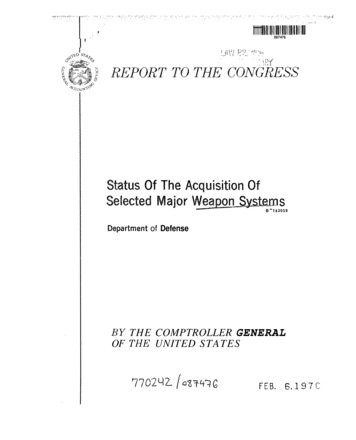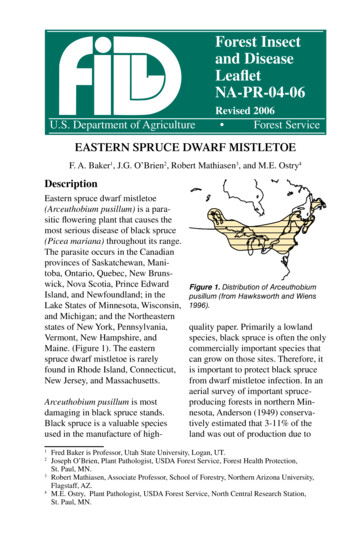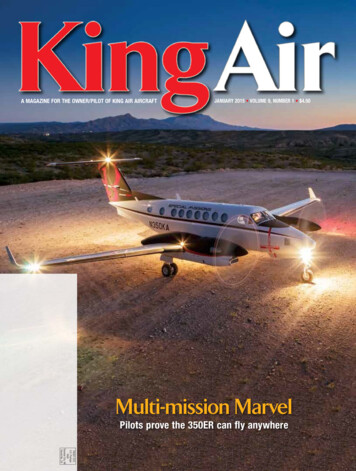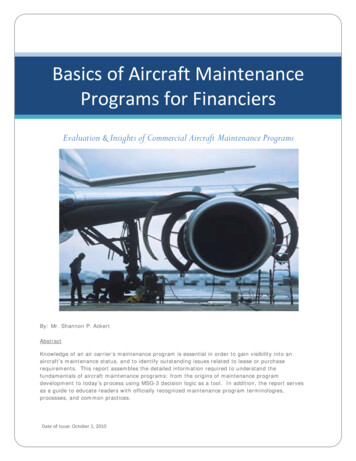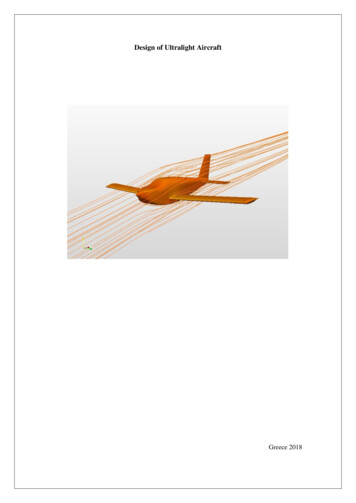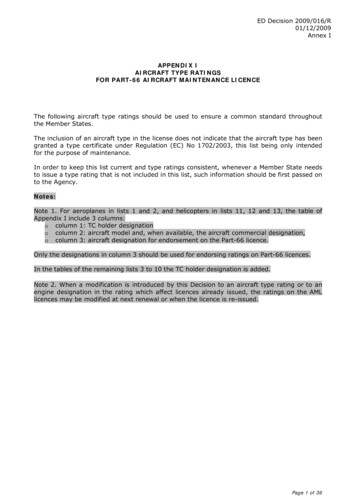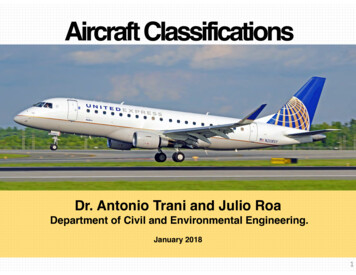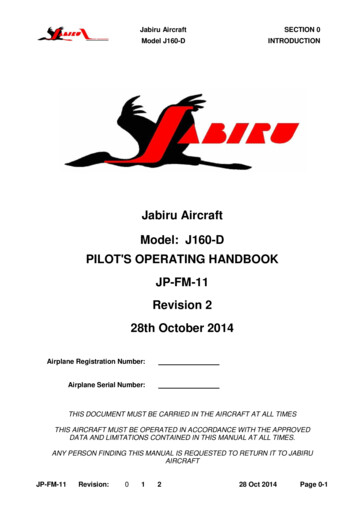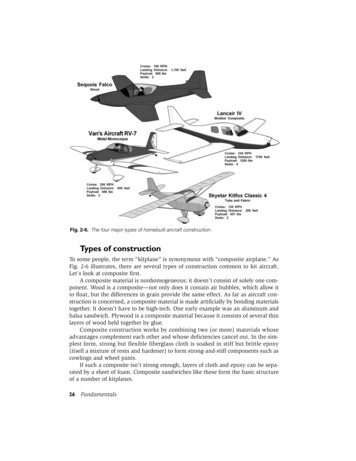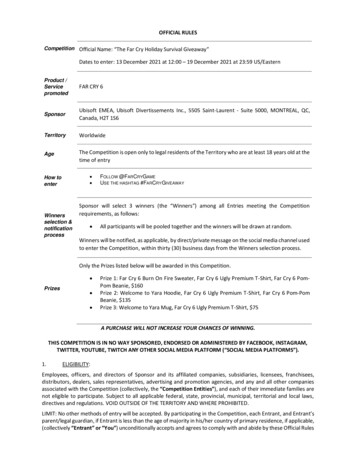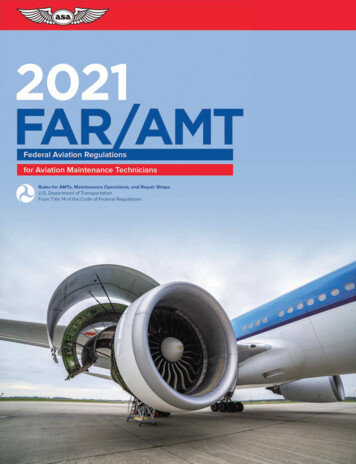
Transcription
2021FAR/AMTFederal Aviation Regulationsfor Aviation Maintenance TechniciansRules for AMTs, Maintenance Operations, and Repair ShopsU.S. Department of TransportationFrom Title 14 of the Code of Federal RegulationsTMUpdated and published byAVIATION SUPPLIES & ACADEMICS, INC.Newcastle, Washingtonasa2fly.com
FAR-AMT(Federal Aviation Regulations for Aviation Maintenance Technicians)2021 EditionAviation Supplies & Academics, Inc.7005 132nd Place SENewcastle, Washington 98059asa@asa2fly.com 425-235-1500 asa2fly.com 1945–2020 Aviation Supplies & Academics, Inc.All rights reserved.This publication contains current regulations as of July 15, 2020.Visit the FAA’s website to review changes to the regulations:http://www.faa.gov/regulations policies/faa regulations/Visit ASA’s website to sign-up for free FAR/AIM Update subscription service:http://www.asa2fly.com/farupdateAlso visit ASA’s website for a Reader Resource page for this book with additionalregulatory information pertinent to Aviation Maintenance Technicians:http://www.asa2fly/reader/faramtNone of the material in this publication supersedes any documents, procedures,or regulations issued by the Federal Aviation Administration or Department ofTransportation.ASA does not claim copyright on any material published herein that was taken fromUnited States government sources.Front cover photo: iStock.com/Jacek SopotnickiASA-21-FAR-AMT-PDISBN 978-1-61954-963-0Additional formats available:Print BookISBN 978-1-61954-960-9KindleISBN 978-1-61954-962-3eBook ePub ISBN 978-1-61954-961-6eBundleISBN 978-1-61954-964-7 (print eBook PDF download code)Stay informed with ASA online lywww.facebook.com/asa2flyii Aviation Supplies & Academics. Inc.
IntroductionASA 2021 FAR/AIM SeriesFAR/AIM FAR for Flight Crew FAR for AMTASA has been supplying the standard reference of the industry, the FAR/AIM series, for more than 75years. The 2021 series continues to provide information directly from the Federal Aviation Regulations andthe Aeronautical Information Manual. Each regulation Part is preceded by a table of contents. Changessince last year’s printing are identified on Page v. In the AIM, changes are explained in lists at the beginning. It is recommended you familiarize yourself with all the changes to identify those that affect your aviation activities.Changes affecting the regulations can take place daily; the AIM changes every 6 months. ASA tracks allchanges and offers you two options for free Updates: Updates are posted on the ASA website that you can download for free—go to www.asa2fly.com/farupdate You may sign up on our website for ASA’s free service to have Update notices automaticallyemailed to you.Visit the FAA website at www.faa.gov to review Advisory Circulars (AC), Notices of Proposed Rulemaking(NPRM), current regulations, FAA contact details, and FAA Orders and publications. Pilots operatinginternationally should be familiar with Customs and Border Patrol regulations, which can be found atwww.cbp.gov.Although ASA is not a government agency, and we do not write the regulations or the AIM, we do workclosely with the FAA. Questions or concerns can be forwarded to our attention, and we will in turn pass thecomments on to the FAA. They are interested in user-feedback and your comments could foster improvements in the regulations which affect the entire industry.FAR/AIM CommentsAviation Supplies & Academics, Inc.7005 132nd Place SENewcastle, Washington 98059 Aviation Supplies & Academics. Inc.Internet iii
iv Aviation Supplies & Academics. Inc.
Part 34Fuel Venting and Exhaust Emission Requirements for Turbine Engine Powered Airplanes .189.Part 35Airworthiness Standards: Propellers .197.Part 39Airworthiness Directives .203.Part 43Maintenance, Preventive Maintenance, Rebuilding, and Alteration .205.Part 45Identification and Registration Marking .217.Part 47Aircraft Registration .221.Part 48Registration and Marking Requirements for Small Unmanned Aircraft .231.Part 65Certification: Airmen Other Than Flight Crewmembers .235.Part 91General Operating and Flight Rules .251.Part 110General Requirements . 353.Part 119Certification: Air Carriers and Commercial Operators . 355.Part 121 Operating Requirements: Domestic, Flag, and Supplemental Operations.367.Part 125 Certification and Operations of Large Airplanes.387.Part 135 Operating Requirements: Commuter and On-Demand Operations . 435.Part 145 Repair Stations .527.Part 147 Aviation Maintenance Technician Schools .537.Part 183 Representatives of the Administrator . 545.Advisory Circulars .551.FAR Index .641 Aviation Supplies & Academics. Inc.xi3Airworthiness Standards: Aircraft Engines .157.5Part 3313Airworthiness Standards: Normal Category Rotorcraft .101.21Part 2723Continued Airworthiness and Safety Improvements for Transport Category Airplanes .89.26Part 2627Airworthiness Standards: Normal Category Airplanes .75.33Part 2334Certification Procedures for Products and Articles.45.35Part 2139Investigative and Enforcement Procedures .17.43Part 1345Safety Management Systems .13.47Part 548Definitions: General Requirements . 11.65Part 391Definitions and Abbreviations .1.AC 183 147 145 135 125 121 119 110Part 11FAR-AMT Contents
14 CFR Subchapter C— AircraftPART 33AIRWORTHINESS STANDARDS: AIRCRAFT ENGINESApplicability.General.Instructions for Continued Airworthiness.Instruction manual for installing and operating theengine.Engine ratings and operating limitations.Selection of engine power and thrust ratings.33.733.8Subpart B — Design and Construction: 27Applicability.[Reserved]Materials.Fire protection.Durability.Engine cooling.Engine mounting attachments and structure.Accessory attachments.Turbine, compressor, fan, and turbosupercharger rotoroverspeed.33.28 Engine control systems.33.29 Instrument connection.Subpart C — Design and Construction:Reciprocating Aircraft .Vibration.Turbocharger rotors.Fuel and induction system.Ignition system.Lubrication system.Subpart D — Block Tests: Reciprocating Aircraft 5533.57Applicability.General.Vibration test.Calibration tests.Detonation test.Endurance test.Operation test.Engine system and component tests.Teardown inspection.General conduct of block tests.Subpart E — Design and Construction:Turbine Aircraft 79Hydraulic actuating systems.Power or thrust response.Continued rotation.Safety analysis.Bird ingestion.Foreign object ingestion — ice.Rain and hail ingestion.Fuel burning thrust augmentor.Subpart F — Block Tests: Turbine Aircraft ility.General.Vibration test.Engine overtorque test.Calibration tests.Endurance test.Engine overtemperature test.Operation test.Initial maintenance inspection test.Engine system and component tests.Rotor locking tests.Teardown inspection.Blade containment and rotor unbalance tests.Engine-propeller systems tests.Engine tests in auxiliary power unit (APU) mode.Thrust reversers.General conduct of block tests.33Subpart A — GeneralSec.33.133.333.433.5Subpart G — Special Requirements:Turbine Aircraft Engines33.201 Design and test requirements for Early ETOPSeligibility.APPENDICES TO PART 33Appendix A to Part 33 — Instructions for ContinuedAirworthinessAppendix B to Part 33 — Certification Standard AtmosphericConcentrations of Rain and HailAppendix C to Part 33 — [Reserved]Appendix D to Part 33 — Mixed Phase and Ice Crystal IcingEnvelope (Deep Convective Cloud)Authority: 49 U.S.C. 106(g), 40113, 44701, 44702, 44704.Source: Docket No. 3025, 29 FR 7453, June 10, 1964, unless otherwise noted.Editorial Note: For miscellaneous amendments to cross references inthis Part 33, see Amdt. 33–2, 31 FR 9211, July 6, 1966.Applicability.Stress analysis.Vibration.Pressurized engine static parts.Surge and stall characteristics.Bleed air system.Fuel system.Induction system icing.Ignitions system.Engine life-limited parts.Lubrication system. Aviation Supplies & Academics. Inc.157
§33.1Federal Aviation RegulationsSubpart A — General§33.1 Applicability.(a) This part prescribes airworthiness standards for the issueof type certificates and changes to those certificates, for aircraftengines.(b) Each person who applies under part 21 for such a certificate or change must show compliance with the applicable requirements of this part and the applicable requirements of part34 of this chapter.[Amdt. 33–7, 41 FR 55474, Dec. 20, 1976, as amended by Amdt. 33–14,55 FR 32861, Aug. 10, 1990]§33.3 General.Each applicant must show that the aircraft engine concernedmeets the applicable requirements of this part.§33.4 Instructions for Continued Airworthiness.The applicant must prepare Instructions for Continued Airworthiness in accordance with Appendix A to this part that areacceptable to the Administrator. The instructions may be incomplete at type certification if a program exists to ensure theircompletion prior to delivery of the first aircraft with the engineinstalled, or upon issuance of a standard certificate of airworthiness for the aircraft with the engine installed, whichever occurslater.[Amdt. 33–9, 45 FR 60181, Sept. 11, 1980]§33.5 Instruction manual for installing andoperating the engine.Each applicant must prepare and make available to the Administrator prior to the issuance of the type certificate, and to theowner at the time of delivery of the engine, approved instructionsfor installing and operating the engine. The instructions must include at least the following:(a) Installation instructions.(1) The location of engine mounting attachments, the methodof attaching the engine to the aircraft, and the maximum allowable load for the mounting attachments and related structure.(2) The location and description of engine connections to beattached to accessories, pipes, wires, cables, ducts, and cowling.(3) An outline drawing of the engine including overall dimensions.(4) A definition of the physical and functional interfaces withthe aircraft and aircraft equipment, including the propeller whenapplicable.(5) Where an engine system relies on components that arenot part of the engine type design, the interface conditions andreliability requirements for those components upon which engine type certification is based must be specified in the engineinstallation instructions directly or by reference to appropriatedocumentation.(6) A list of the instruments necessary for control of the engine, including the overall limits of accuracy and transient response required of such instruments for control of the operationof the engine, must also be stated so that the suitability of theinstruments as installed may be assessed.(b) Operation instructions.(1) The operating limitations established by the Administrator.(2) The power or thrust ratings and procedures for correctingfor nonstandard atmosphere.(3) The recommended procedures, under normal and extremeambient conditions for —158(i) Starting;(ii) Operating on the ground; and(iii) Operating during flight.(4) For rotorcraft engines having one or more OEI ratings,applicants must provide data on engine performance characteristics and variability to enable the aircraft manufacturer toestablish aircraft power assurance procedures.(5) A description of the primary and all alternate modes, andany back-up system, together with any associated limitations,of the engine control system and its interface with the aircraftsystems, including the propeller when applicable.(c) Safety analysis assumptions. The assumptions of thesafety analysis as described in §33.75(d) with respect to the reliability of safety devices, instrumentation, early warning devices,maintenance checks, and similar equipment or procedures thatare outside the control of the engine manufacturer.[Amdt. 33–6, 39 FR 35463, Oct. 1, 1974, as amended by Amdt. 33–9,45 FR 60181, Sept. 11, 1980; Amdt. 33–24, 72 FR 50867, Sept. 4, 2007;Amdt. 33–25, 73 FR 48123, Aug. 18, 2008; Amdt. 33–26, 73 FR 48284,Aug. 19, 2008]§33.7 Engine ratings and operating limitations.(a) Engine ratings and operating limitations are establishedby the Administrator and included in the engine certificate datasheet specified in §21.41 of this chapter, including ratings andlimitations based on the operating conditions and informationspecified in this section, as applicable, and any other information found necessary for safe operation of the engine.(b) For reciprocating engines, ratings and operating limitations are established relating to the following:(1) Horsepower or torque, r.p.m., manifold pressure, and timeat critical pressure altitude and sea level pressure altitude for —(i) Rated maximum continuous power (relating to unsupercharged operation or to operation in each supercharger modeas applicable); and(ii) Rated takeoff power (relating to unsupercharged operationor to operation in each supercharger mode as applicable).(2) Fuel grade or specification.(3) Oil grade or specification.(4) Temperature of the —(i) Cylinder;(ii) Oil at the oil inlet; and(iii) Turbosupercharger turbine wheel inlet gas.(5) Pressure of —(i) Fuel at the fuel inlet; and(ii) Oil at the main oil gallery.(6) Accessory drive torque and overhang moment.(7) Component life.(8) Turbosupercharger turbine wheel r.p.m.(c) For turbine engines, ratings and operating limitations areestablished relating to the following:(1) Horsepower, torque, or thrust, r.p.m., gas temperature, andtime for —(i) Rated maximum continuous power or thrust (augmented);(ii) Rated maximum continuous power or thrust (unaugmented);(iii) Rated takeoff power or thrust (augmented);(iv) Rated takeoff power or thrust (unaugmented);(v) Rated 30–minute OEI power;(vi) Rated 2-1/2 minute OEI power;(vii) Rated continuous OEI power; and(viii) Rated 2-minute OEI power;(ix) Rated 30-second OEI power; and(x) Auxiliary power unit (APU) mode of operation.(2) Fuel designation or specification. Aviation Supplies & Academics. Inc.
Part 33: Airworthiness Standards: Aircraft Engines[Amdt. 33–6, 39 FR 35463, Oct. 1, 1974, as amended by Amdt. 33–10,49 FR 6850, Feb. 23, 1984; Amdt. 33–11, 51 FR 10346, Mar. 25, 1986;Amdt. 33–12, 53 FR 34220, Sept. 2, 1988; Amdt. 33–18, 61 FR 31328,June 19, 1996; Amdt. 33–26, 73 FR 48284, Aug. 19, 2008; Amdt. 33–30,74 FR 45310, Sept. 2, 2009]§33.8 Selection of engine power and thrust ratings.(a) Requested engine power and thrust ratings must be selected by the applicant.(b) Each selected rating must be for the lowest power or thrustthat all engines of the same type may be expected to produceunder the conditions used to determine that rating.[Amdt. 33–3, 32 FR 3736, Mar. 4, 1967]Subpart B — Design andConstruction: General§33.11 Applicability.This subpart prescribes the general design and constructionrequirements for reciprocating and turbine aircraft engines.§33.13 [Reserved]§33.15 Materials.The suitability and durability of materials used in the enginemust —(a) Be established on the basis of experience or tests; and(b) Conform to approved specifications (such as industry ormilitary specifications) that ensure their having the strength andother properties assumed in the design data.(Secs. 313(a), 601, and 603, 72 Stat. 759, 775, 49 U.S.C. 1354(a), 1421,and 1423; sec. 6(c), 49 U.S.C. 1655(c))[Amdt. 33–8, 42 FR 15047, Mar. 17, 1977, as amended by Amdt. 33–10,49 FR 6850, Feb. 23, 1984]§33.17 Fire protection.(a) The design and construction of the engine and the materials used must minimize the probability of the occurrenceand spread of fire during normal operation and failure conditions, and must minimize the effect of such a fire. In addition, thedesign and construction of turbine engines must minimize theprobability of the occurrence of an internal fire that could resultin structural failure or other hazardous effects.(b) Except as provided in paragraph (c) of this section, eachexternal line, fitting, and other component, which contains orconveys flammable fluid during normal engine operation, mustbe fire resistant or fireproof, as determined by the Administrator.Components must be shielded or located to safeguard againstthe ignition of leaking flammable fluid.(c) A tank, which contains flammable fluids and any associated shut-off means and supports, which are part of and attached to the engine, must be fireproof either by constructionor by protection unless damage by fire will not cause leakageor spillage of a hazardous quantity of flammable fluid. For a reciprocating engine having an integral oil sump of less than 23.7liters capacity, the oil sump need not be fireproof or enclosed bya fireproof shield.(d) An engine component designed, constructed, and installed to act as a firewall must be:(1) Fireproof;(2) Constructed so that no hazardous quantity of air, fluid orflame can pass around or through the firewall; and,(3) Protected against corrosion;(e) In addition to the requirements of paragraphs (a) and (b) ofthis section, engine control system components that are locatedin a designated fire zone must be fire resistant or fireproof, asdetermined by the Administrator.(f) Unintentional accumulation of hazardous quantities offlammable fluid within the engine must be prevented by draining and venting.(g) Any components, modules, or equipment, which are susceptible to or are potential sources of static discharges or electrical fault currents must be designed and constructed to beproperly grounded to the engine reference, to minimize the riskof ignition in external areas where flammable fluids or vaporscould be present.[Docket No. FAA–2007–28503, 74 FR 37930, July 30, 2009] Aviation Supplies & Academics. Inc.15933(3) Oil grade or specification.(4) Hydraulic fluid specification.(5) Temperature of —(i) Oil at a location specified by the applicant;(ii) Induction air at the inlet face of a supersonic engine, including steady state operation and transient over-temperatureand time allowed;(iii) Hydraulic fluid of a supersonic engine;(iv) Fuel at a location specified by the applicant; and(v) External surfaces of the engine, if specified by the applicant.(6) Pressure of —(i) Fuel at the fuel inlet;(ii) Oil at a location specified by the applicant;(iii) Induction air at the inlet face of a supersonic engine, including steady state operation and transient overpressure andtime allowed; and(iv) Hydraulic fluid.(7) Accessory drive torque and overhang moment.(8) Component life.(9) Fuel filtration.(10) Oil filtration.(11) Bleed air.(12) The number of start-stop stress cycles approved for eachrotor disc and spacer.(13) Inlet air distortion at the engine inlet.(14) Transient rotor shaft overspeed r.p.m., and number ofoverspeed occurrences.(15) Transient gas overtemperature, and number of overtemperature occurrences.(16) Transient engine overtorque, and number of overtorqueoccurrences.(17) Maximum engine overtorque for turbopropeller and turboshaft engines incorporating free power turbines.(18) For engines to be used in supersonic aircraft, engine rotor windmilling rotational r.p.m.(d) In determining the engine performance and operating limitations, the overall limits of accuracy of the engine control system and of the necessary instrumentation as defined in §33.5(a)(6) must be taken into account.§33.17
§33.19§33.19 Durability.(a) Engine design and construction must minimize the development of an unsafe condition of the engine between overhaul periods. The design of the compressor and turbine rotorcases must provide for the containment of damage from rotorblade failure. Energy levels and trajectories of fragments resulting from rotor blade failure that lie outside the compressor andturbine rotor cases must be defined.(b) Each component of the propeller blade pitch control system which is a part of the engine type design must meet the requirements of §§35.21, 35.23, 35.42 and 35.43 of this chapter.[Docket No. 3025, 29 FR 7453, June 10, 1964; as amended by Amdt.33–9, 45 FR 60181, Sept. 11, 1980; Amdt. 33–10, 49 FR 6851, Feb. 23,1984; Amdt. 33–28, 73 FR 63346, Oct. 24, 2008]§33.21 Engine cooling.Engine design and construction must provide the necessarycooling under conditions in which the airplane is expected tooperate.§33.23 Engine mounting attachments andstructure.(a) The maximum allowable limit and ultimate loads for engine mounting attachments and related engine structure mustbe specified.(b) The engine mounting attachments and related enginestructure must be able to withstand —(1) The specified limit loads without permanent deformation;and(2) The specified ultimate loads without failure, but may exhibitpermanent deformation.[Amdt. 33–10, 49 FR 6851, Feb. 23, 1984]§33.25 Accessory attachments.The engine must operate properly with the accessory driveand mounting attachments loaded. Each engine accessory driveand mounting attachment must include provisions for sealingto prevent contamination of, or unacceptable leakage from, theengine interior. A drive and mounting attachment requiring lubrication for external drive splines, or coupling by engine oil, mustinclude provisions for sealing to prevent unacceptable loss of oiland to prevent contamination from sources outside the chamberenclosing the drive connection. The design of the engine mustallow for the examination, adjustment, or removal of each accessory required for engine operation.[Amdt. 33–10, 49 FR 6851, Feb. 23, 1984]§33.27 Turbine, compressor, fan, andturbosupercharger rotor overspeed.(a) For each fan, compressor, turbine, and turbosuperchargerrotor, the applicant must establish by test, analysis, or a combination of both, that each rotor will not burst when operated inthe engine for 5 minutes at whichever of the conditions definedin paragraph (b) of this section is the most critical with respectto the integrity of such a rotor.(1) Test rotors used to demonstrate compliance with this section that do not have the most adverse combination of materialproperties and dimensional tolerances must be tested at conditions which have been adjusted to ensure the minimum specification rotor possesses the required overspeed capability. Thiscan be accomplished by increasing test speed, temperature,and/or loads.160Federal Aviation Regulations(2) When an engine test is being used to demonstrate compliance with the overspeed conditions listed in paragraph (b)(3) or(b)(4) of this section and the failure of a component or system issudden and transient, it may not be possible to operate the engine for 5 minutes after the failure. Under these circumstances,the actual overspeed duration is acceptable if the required maximum overspeed is achieved.(b) When determining the maximum overspeed condition applicable to each rotor in order to comply with paragraphs (a) and(c) of this section, the applicant must evaluate the following rotorspeeds taking into consideration the part’s operating temperatures and temperature gradients throughout the engine’s operating envelope:(1) 120 percent of the maximum permissible rotor speed associated with any of the engine ratings except one-engine-inoperative (OEI) ratings of less than 2-1/2 minutes.(2) 115 percent of the maximum permissible rotor speed associated with any OEI ratings of less than 2-1/2 minutes.(3) 105 percent of the highest rotor speed that would resultfrom either:(i) The failure of the component or system which, in a representative installation of the engine, is the most critical withrespect to overspeed when operating at any rating conditionexcept OEI ratings of less than 2-1/2 minutes, or(ii) The failure of any component or system in a representativeinstallation of the engine, in combination with any other failureof a component or system that would not normally be detectedduring a routine pre-flight check or during normal flight operation, that is the most critical with respect to overspeed, except asprovided by paragraph (c) of this section, when operating at anyrating condition except OEI ratings of less than 2-1/2 minutes.(4) 100 percent of the highest rotor speed that would resultfrom the failure of the component or system which, in a representative installation of the engine, is the most critical withrespect to overspeed when operating at any OEI rating of lessthan 2-1/2 minutes.(c) The highest overspeed that results from a complete lossof load on a turbine rotor, except as provided by paragraph (f)of this section, must be included in the overspeed conditionsconsidered by paragraphs (b)(3)(i), (b)(3)(ii), and (b)(4) of thissection, regardless of whether that overspeed results from a failure within the engine or external to the engine. The overspeedresulting from any other single failure must be considered whenselecting the most limiting overspeed conditions applicable toeach rotor. Overspeeds resulting from combinations of failuresmust also be considered unless the applicant can show that theprobability of occurrence is not greater than extremely remote(probability range of 10-7 to 10-9 per engine flight hour).(d) In addition, the applicant must demonstrate that each fan,compressor, turbine, and turbosupercharger rotor complies withparagraphs (d)(1) and (d)(2) of this section for the maximumoverspeed achieved when subjected to the conditions specified in paragraphs (b)(3) and (b)(4) of this section. The applicantmust use the approach in paragraph (a) of this section whichspecifies the required test conditions.(1) Rotor Growth must not cause the engine to:(i) Catch fire,(ii) Release high-energy debris through the engine casing orresult in a hazardous failure of the engine casing,(iii) Generate loads greater than those ultimate loads specifiedin §33.23(a), or(iv) Lose the capability of being shut down.(2) Following an overspeed event and after continued operation, the rotor may not exhibit conditions such as cracking ordistortion which preclude continued safe operation. Aviation Supplies & Academics. Inc.
(e) The design and functioning of engine control systems, instruments, and other methods not covered under §33.28 mustensure that the engine operating limitations that affect turbine,compressor, fan, and turbosupercharger rotor structural integritywill not be exceeded in service.(f) Failure of a shaft section may be excluded from consideration in determining the highest overspeed that would resultfrom a complete loss of load on a turbine rotor if the applicant:(1) Identifies the shaft as an engine life-limited-part and complies with §33.70.(2) Uses material and design features that are well understood and that can be analyzed by well-established and validated stress analysis techniques.(3) Determines, based on an assessment of the environmentsurrounding the shaft section, that environmental influences areunlikely to cause a shaft failure. This assessment must includecomplexity of design, corrosion, wear, vibration, fire, contactwith adjacent components or structure, overheating, and secondary effects from other failures or combination of failures.(4) Identifies and declares, in accordance with §33.5, a
closely with the FAA. Questions or concerns can be forwarded to our attention, and we will in turn pass the comments on to the FAA. They are interested in user-feedback and your comments could foster improve-ments in the regulations which affect the entire industry. FAR/AIM Comments Aviation Supplies & Academics, Inc. Internet www.asa2fly.com
